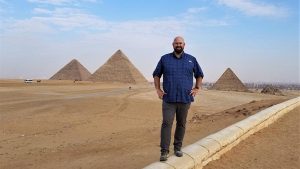
2019 P. E. MACALLISTER FELLOWSHIP FIELD REPORT: TERRY NICHOLS
Archaeology: Above the Dirt
This past year, I was a recipient of the P.E. MacAllister Excavation Fellowship. This made it possible for me to participate in the Karnak Great Hypostyle Hall Project (KGHHP) at the Temple of Karnak in Luxor, Egypt in December 2019. I served as the lead student epigrapher for the Tandy Institute for Archaeology at Southwestern Baptist Theological Seminary in our portion of the project.
The Temple of Karnak is one of the largest religious structures ever built, spanning a massive 200+ acres. The focal point of the complex is the Temple of Amun, highlighted by the Great Hypostyle Hall. It is the largest hypostyle hall in the world, consisting of 134 columns of stone with the 12 central columns rising over 20 meters, or 70+ ft. For scale, I stand about 6’1”.
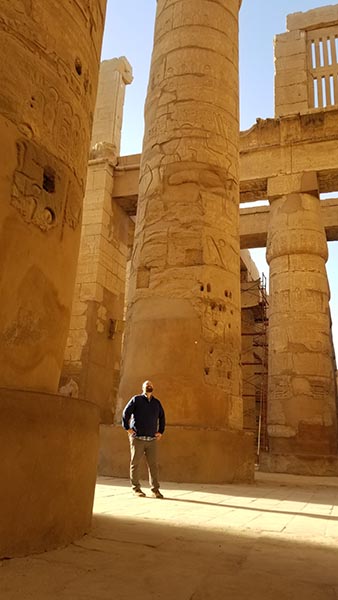
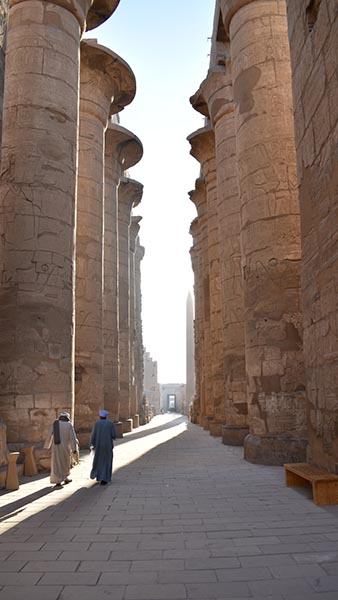
This was the third field season at the Karnak Temple by the Tandy Institute. The Tandy is performing an epigraphic survey of the inscriptions on the western exterior wall of the ‘Cour de la Cachette’, a side court of the Great Hypostyle Hall. The epigraphic survey of the Tandy is led by Dr. Mark Janzen and is a consortium member in the KGHHP with the University of Memphis led by Dr. Peter Brand and Dr. Jean Revez at the Université du Québec à Montréal. Properly, epigraphy is the scientific recordation of inscriptions and reliefs of a monument “so precise it could stand in the absence of the original monument” according to James Breasted. The importance of this project is to capture the scenes of the western wall due to exposure, weathering, and other natural sources of damage. The Tandy’s project records the reliefs and inscriptions of the pharaoh Merneptah, which include battle scenes from the land of Canaan. One of the main scenes on the wall is the Battle of Ashkelon, one of the few surviving places names remaining on the wall. The scientific preservation of these reliefs helps to connect the archaeological data from sites such as Ashkelon and Gezer.
As the lead student epigrapher, my work started before we arrived in the field. I acted as a digital/graphic artist and sketched all of the inscriptions and reliefs using orthomosaic photos created during the first field season.
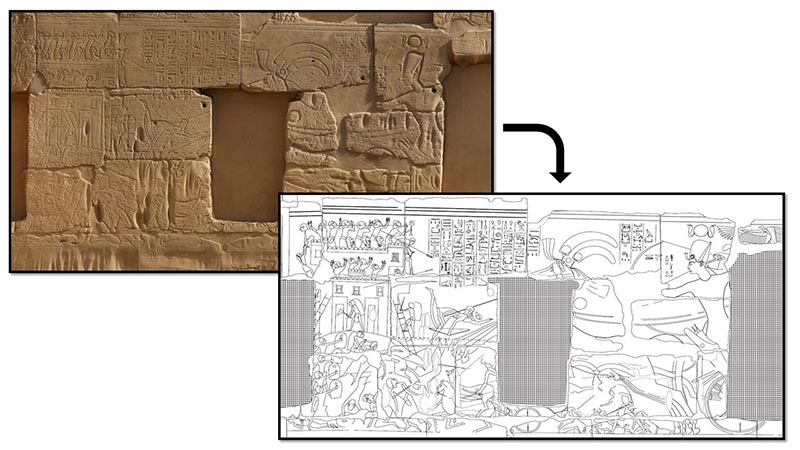
The full wall contains nearly 400 high-quality photographs stitched together using specialized software to create a single orthomosaic photograph. This photo is divided into scenes (such as the Ashkelon Battle scene shown) which serves as the base where I ‘trace’ the inscriptions digitally. Then all of the sketches of each scene are copied into a template, printed, bound into booklets where they were brought to the field where they are examined for accuracy.
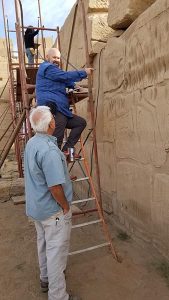
Terry Nichols discussing the scene with Dr. Steven Ortiz.
Once in the field, these drawings were examined, then measured, edited, corrected, and updated by the rest of the team to be as scientifically accurate as possible. Every line, hieroglyph, and even damage was inspected. It is done best square and level with the inscriptions which requires scaffolding, some areas rising 4 stories high. I was responsible for directing the other student epigraphers, double-checking their work, and acting as intermediary between the project directors and student epigraphers.
The title of this report, “above the dirt”, refers to the fact that in the Tandy’s project at the Karnak Temple, we were above the dirt, sometimes 4 stories above it, rather than in the dirt as with many archaeological projects. Yet, working ‘above the dirt’ on Merneptah’s reliefs and inscriptions at Karnak demonstrated the connection to sites such as Ashkelon and Gezer that strengthen the authenticity of these attacks.
Terry Nichols is a Ph.D. student in Archaeology at Southwestern Baptist Theological Seminary in the Tandy Institute for Archaeology. He has worked with the Karnak Great Hypostyle Hall Project in Luxor, Egypt led by Dr. Peter Brand, as well as served on multiple archaeological excavation projects in Israel, notably at Tel Gezer under Dr. Steve Ortiz and Tel Burna with Dr. Itzick Shai. His research interests include the archaeology of the Southern Levant in the Late Bronze through Iron Age and its intersections with Egypt in the New Kingdom through the Third Intermediate Period. Terry is also a certified IT computer technician and uses that expertise in the intersection of archaeology and digital technology.
